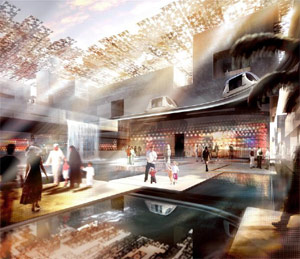This article is more than 1 year old
United Arab Emirates plan zero carbon desert city
Carless utopia
The United Arab Emirates will today formally unveil plans for an all-new, zero carbon desert city - seven square kilometres of carless utopia designed to house 50,000 people.
 The project - dubbed Masdar ("the source") - is being designed by top Brit architect Lord Foster, and is described as "the world's first sustainable city". Much of its energy needs will be provided by solar solutions, while careful planning will help protect the inhabitatants from the 50°C summer heat.
The project - dubbed Masdar ("the source") - is being designed by top Brit architect Lord Foster, and is described as "the world's first sustainable city". Much of its energy needs will be provided by solar solutions, while careful planning will help protect the inhabitatants from the 50°C summer heat.
Foster senior partner Gerard Evenden said: "It's extremely ambitious. We were invited to design a zero-carbon city. In this harsh place we needed to look back at history and see how ancient settlements had adapted to their environments."
The city will be aligned north-east to south-west to give the "optimum balance of sunlight and shade", as the Guardian puts it. Buildings will be limited to five storeys, and packed around narrow streets no more than 3 metres wide and 70 metres long to "develop a micro-climate and keep the air moving".
Additional cooling will be provided by wind towers which will harness the desert breeze and "flush out" hot air.
The whole of Masdar is designed on a three-level concept, one housing a light railway to connect the city with nearby Abu Dhabi, a second reserved for pedestrians, with a third set aside for "personalised rapid transport pods," described by Evenden as "little vehicles like driverless personal taxis which run on tracks or magnetic discs in the road".
He added: "It's a tried technology. They are in production in Holland, and used to move containers around in Rotterdam port."
On a more practical level, Evenden said: "We will start with a large solar power station which will provide the energy to construct the city. Some 80 per cent of all the roof space will be used to generate solar power, and because we expect technology to improve as we are building it, we hope we will later be able to remove the power plant. We could 'borrow' energy from outside, but we are trying to prove it can all be generated in the confines of the site."
While Abu Dhabi is the world's richest city, with each of its 420,000 inhabitants worth a nominal $17m, they are responsible for "more greenhouse gas emissions per capita than any other population in the world", the Guardian explains.
In an attempt to clean up its act, the UAE is this week expected to announce a $500m deal to manufacture thin-film solar panels, elevating Masdar to a "centre of the global solar energy manufacturing industry".
Jean-Paul Jeanrenaud, head of WWF's One Planet Living initiative, enthused: "This will be the global capital of the renewable energy revolution. It's the first oil producing nation to have taken such a significant step towards sustainable living."
However, Tony Juniper, director of Friends of the Earth, cautioned: "The numbers must be put into perspective. They are spending welcome billions of dollars on renewables but trillions are still going into climate-changing oil economies. The future is the Sun and renewables, but there is no time to wait for this revolution." ®
